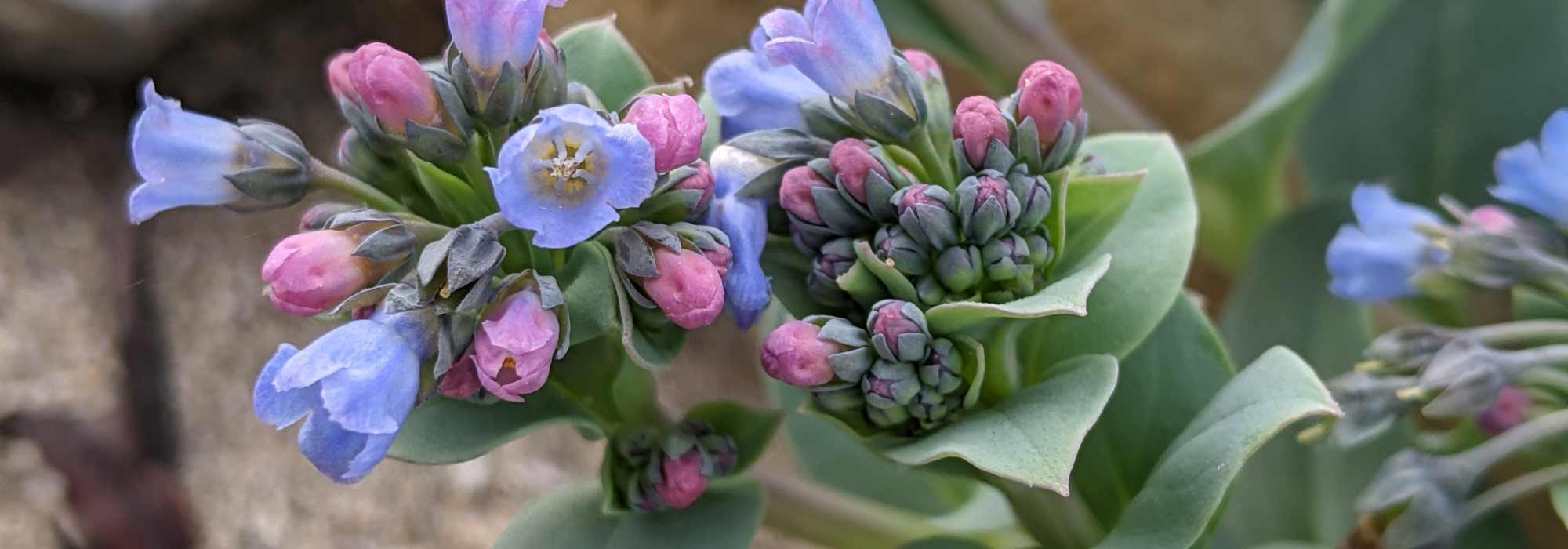
Mertensia maritima: sowing, growing, harvesting
Contents
Mertensia maritima in a nutshell
- Mertensia maritima is a hardy, perennial, creeping young plant with deciduous leaves
- Also known as “oyster plant”, it is grown for its surprisingly briny-flavoured leaves
- It adds a hint of oyster flavour to recipes!
- It requires well-drained soil to thrive
- Very hardy, it is a perennial young plant; however, it is delicate to cultivate and is best suited for the most experienced gardeners
A word from our expert
Mertensia maritima is a herbaceous plant also known as “vegetable oyster,” “oyster-flavoured plant,” or simply “oyster plant,” referring to the taste and the thick, succulent nature of its leaves. Although it belongs to the same family as borage, the sea bluebell offers a much more pronounced briny flavour than the latter.
Until recently, it was largely unknown to the public (this plant had only been cultivated by collector gardeners for about thirty years), and it was the chefs of Michelin-starred restaurants who first brought it to wider attention. Now a victim of its own success and excessive wild harvesting, it is currently a protected plant that is virtually extinct in the wild. Its oyster-flavoured leaves are typically consumed raw and can accompany fish dishes and salads.
The vegetable oyster is also a very decorative plant, grown in rockeries, troughs, pots, basins, window boxes, vegetable gardens, or even herb gardens… It enhances these spaces with its beautiful, slightly blue-tinged foliage and its small bell-shaped flowers in shades of blue-violet.
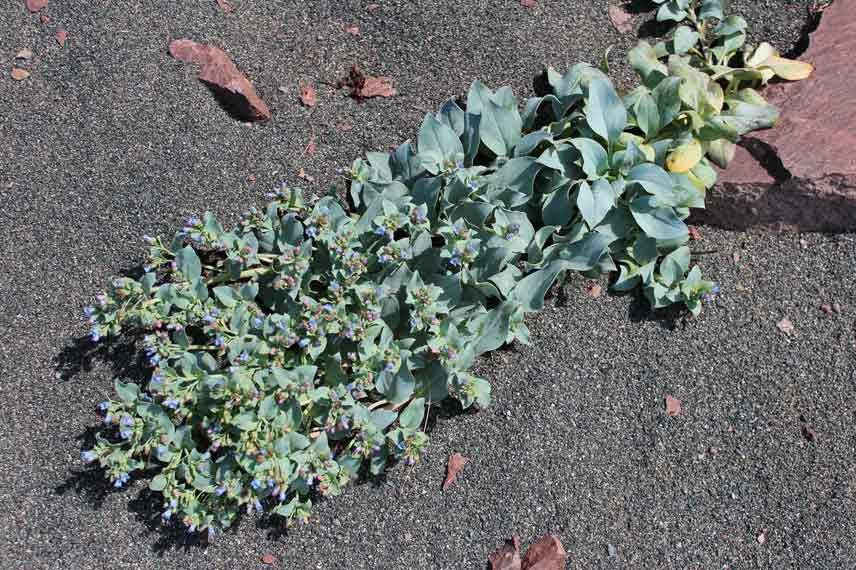
Mertensia maritima growing in the wild © Rob Foster – iNaturalist
Hardy down to -30°C, Mertensia maritima can be grown in the ground or in pots, and can be harvested as needed. A perennial despite its deciduous foliage, it can remain in place for several consecutive years, provided it is cultivated in perfectly drained soil. The vegetable oyster remains a delicate plant, which complicates its cultivation.
Description and Botany
Botanical data
- Latin name Mertensia maritima
- Family Boraginaceae
- Common name Oyster leaf, Vegetable oyster, Culinary oyster, Oyster-flavoured plant, Sea blood, Virginia pulmonaria, Mertensia maritime
- Flowering June to October
- Height 10 to 15 cm tall
- Exposure semi-shaded, light sun
- Soil type rich, cool, drained, sandy
- Hardiness very hardy (-30°C)
Native to the coastal dunes of the Atlantic and the English Channel, Mertensia maritima is a perennial herbaceous plant with a creeping habit that belongs to the Boraginaceae family, just like borage. While this herbaceous plant once thrived along the entire Atlantic coastline on both sides of the ocean (it is also found in Canada), it has been wiped from the Norman landscape since. The trampling of the dunes (its natural habitat) and wild harvesting are the two main causes of its disappearance. In France, it is now a protected species. Therefore, it is completely forbidden to harvest it from the wild.
Mertensia maritima has many different names. It is known as “vegetable oyster”, “oyster-flavoured plant”, mertensia maritime, sea blood, Virginia pulmonaria, or simply oyster leaf.
Mertensia maritima has a weak root system, making it fragile and vulnerable. Its soft, almost trailing clumps reach between 10 and 15 cm in height and 40 to 70 cm in width. Its deciduous, semi-evergreen foliage displays a silvery-blue-green colour. The oblong, petiolate leaves typically take on a spoon-like shape and are borne on lighter stems. In winter, its leaves disappear, only to re-emerge the following spring. In summer, the oyster leaf produces bell-shaped flowers in violet-blue, which are very decorative. The seeds are black and taper to a point.
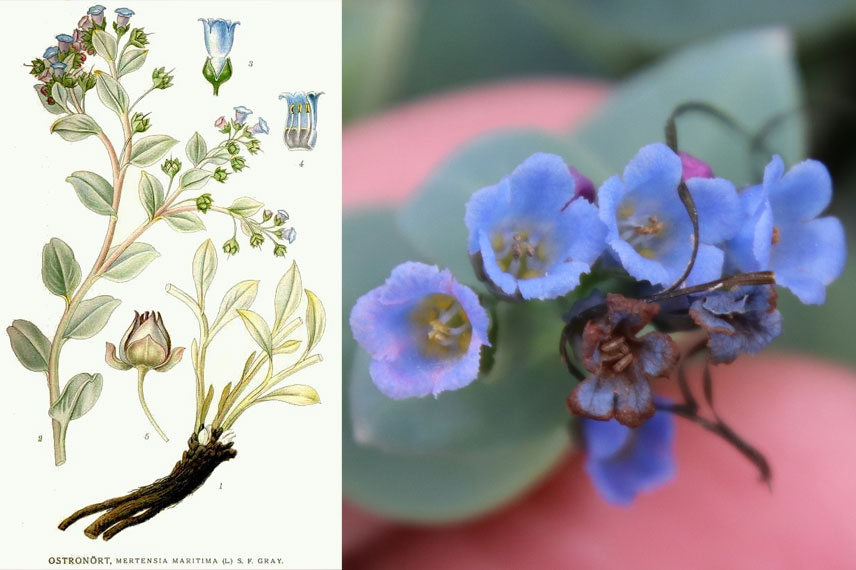
Botanical Drawing © Carl Axel Magnus Lindman | Flowers of oyster leaf © Millie Basden – iNaturalist
The vegetable oyster is also a plant rich in potassium, calcium, magnesium, iron, manganese, zinc, and copper.
Main species and varieties
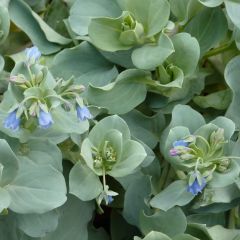
Mertensia maritima
- Periodo di fioritura July to October
- Altezza a maturità 15 cm
Sowing and planting of Mertensia maritima
Where to install Mertensia maritima?
The oyster plant prefers partially shaded locations, or light sun. Always favour a partially shaded exposure over a sunny one, even if the latter offers little direct sunlight.
Install the oyster plant in a preferably rich, cool, well-drained, sandy soil. If the soil is too heavy, add some sand to your soil at the time of planting.
When and how to sow Mertensia maritima?
Sowing of Mertensia maritima takes place in spring under cover, or in autumn outdoors.
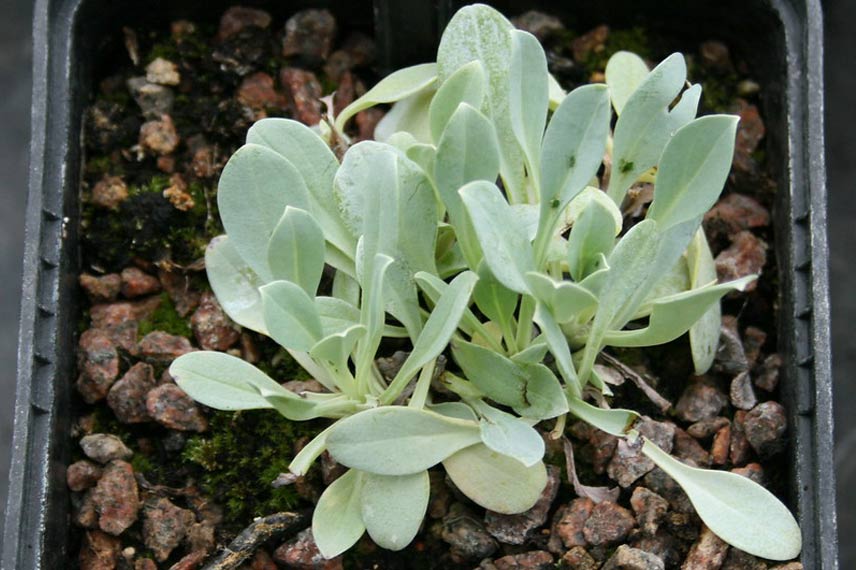
Young plants of oyster plant in pot © Unconventional Emma – Flickr
Sowing indoors
You must strictly adhere to a cold stratification period for your seeds, whether they have been collected in autumn or purchased commercially. This will significantly improve the germination rate.
- Place your oyster plant seeds in the vegetable drawer of your refrigerator for 3 to 6 weeks.
- Then sow the seeds in a warm environment, between 15 and 20°C, in a substrate composed of 50% very good potting soil and 50% sand. Barely cover them.
- Place your Mertensia maritima seedlings in a well-lit area, and keep the substrate slightly moist.
- Transplant the seedlings at the 4 or 5 leaf stage into peat pots.
Sowing outdoors
- In autumn, prefer to sow your oyster plant seeds outdoors, in open ground or in pots.
- Sow in rich, cool, light, and sandy soil.
- Barely cover the seeds with soil.
- Germination occurs in the following spring between February and April.
Planting the oyster plant
Planting of Mertensia maritima takes place in spring in open ground or in pots, between March and May, or in autumn between September and October.
Planting in open ground
- Several months before planting, loosen the soil and add compost by scratching it in to a depth of 5 cm.
- Dig a hole whose volume is three times that of the root ball.
- Install a layer of gravel at the bottom of the planting hole to improve drainage.
- Cover it with a bit of soil, and place the root ball of the oyster plant.
- Cover everything with a bit of fine soil, firm it down, and water.
Planting in pots
- Choose a pot with a diameter of at least 50 cm.
- Place a layer of gravel or clay balls at the bottom of the pot.
- Fill the pot with a substrate made of a mixture of 50% very good potting soil and 50% sand.
- Place the root ball of Mertensia maritima.
- Cover with a bit of substrate and firm it down well before watering.
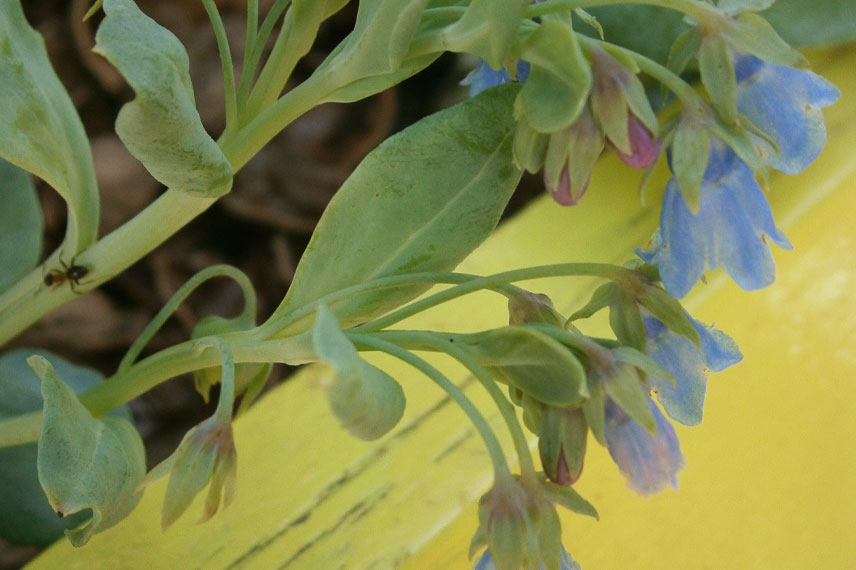 Mertensia maritima grown in container © Meneerke bloem – Flickr
Mertensia maritima grown in container © Meneerke bloem – Flickr
Note: Growing the oyster plant in pots is much easier to achieve than growing it in open ground.
Read also
Borage: sowing, harvest, benefitsHarvest, storage and use
Harvesting
The harvest of oyster leaves is carried out as needed, from spring to autumn. Wait until the plant is well established before starting your pickings. Never harvest more than 1/3 of the leaves from a single plant at a time. It is preferable to harvest them in the morning to enjoy the maximum of their aromas.
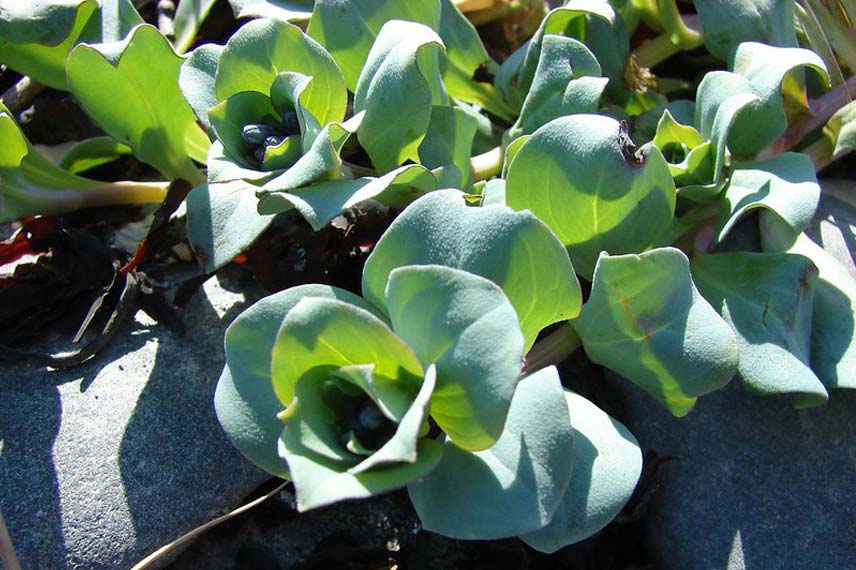
Foliage of Mertensia maritima © Emma Forsberg – Flickr
Storage
Freshly picked oyster leaves can be stored in the vegetable drawer of the refrigerator for a few days (no more than 4 or 5). Be sure to place the leaves in an airtight container before putting them in the fridge. Note that it is also possible to preserve Mertensia maritima in vinegar, similar to samphire or pickles.
Culinary uses
Oyster leaves can be consumed raw or cooked (like spinach). However, it is the raw leaves that offer their full iodised flavour, thus retaining their surprising and unique character. Be careful to use only a few leaves at a time, so that the iodine does not overpower the entire dish.
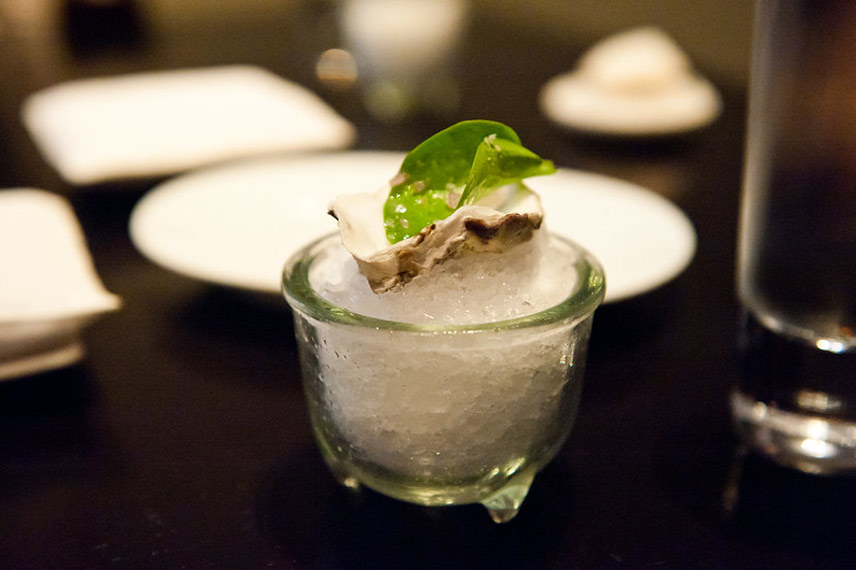
Oyster leaf © star5112 – Flickr
Raw oyster leaves can be enjoyed as a starter or used to enhance the flavour of:
- a mixed salad,
- a cooked salmon fillet,
- a fish carpaccio,
- a seafood platter,
- tomatoes accompanied by mozzarella,
- a risotto,
- etc.
Good to know: the flowers of the oyster plant are also edible.
Nutritional benefits
The nutritional qualities of Mertensia maritima have been highlighted by an analysis from the National Institute for Agricultural Research (Inra). This study reveals the plant’s high richness in trace elements.
- Zinc is present in large quantities, at 95 mg/kg. Zinc is a powerful antioxidant and a trace element that contributes to the immune defence of the body. It also has a proven effect on memory.
- The oyster-flavoured plant also contains manganese at 83 mg/kg. This strengthens immune defences and regulates allergy responses.
- Potassium is present in the oyster plant at 64 mg/kg. It plays a role in muscle and heart contraction, and its deficiency is responsible for fatigue and muscle cramps.
- Mertensia maritima is also very rich in iron. It contains 54 mg/kg, which is 20 times more than spinach, which contains only 2.7 mg/100 g. Note that an iron deficiency can lead to anaemia and reduce physical and intellectual capacity.
Care and maintenance of sea Mertensia
We have seen that growing Mertensia maritima in open ground is quite complex due to its fragile root system. The care for this plant varies depending on whether you are growing it in a container or in the garden.
In open ground
To strengthen the plant, prune the stems by half and remove two-thirds of the flowers to encourage leaf production.
Be aware that despite its great hardiness, the oyster plant can suffer from cold, especially in cases of excessive moisture. Remember to protect its young shoots from spring frosts, as the vegetation of the oyster plant starts early in late winter.
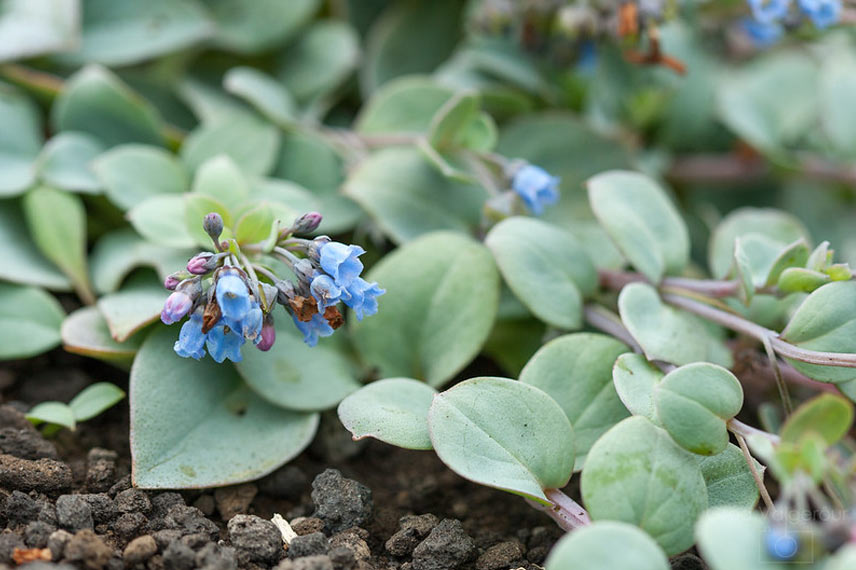
Mertensia maritima grown in open ground © Gróa Valgerður Ingimundardóttir – Flickr
The oyster plant enjoys cool soils during summer, provided that the moisture is not excessive. Water it as needed during the summer period, and stop all watering during winter. Ideally, install a canopy above your oyster plants from October to protect them from winter rains. Be careful, even in summer, water should never stagnate at the base of Mertensia maritima.
In pots
If you live in a rainy region, it is better to grow the oyster plant in pots to protect it more easily from the elements. In summer, water your plants moderately, ensuring to remove water from the saucer. In winter, bring your pots into a frost-free area, such as a cold greenhouse or a non-heated conservatory.
Diseases and potential pests of Mertensia maritima
If Mertensia maritima is a plant that is not particularly prone to diseases (it is not known to have any specific afflictions), it is, however, often subject to attacks from slugs and snails! Gastropods are indeed very fond of it and can even destroy an entire young plant in a single night. To combat slugs and snails, do not hesitate to spread ash, crushed egg shells, hemp flakes, or even lava rock on the soil. Growing the oyster plant in a raised pot also has the advantage of preventing gastropods from accessing the plant.
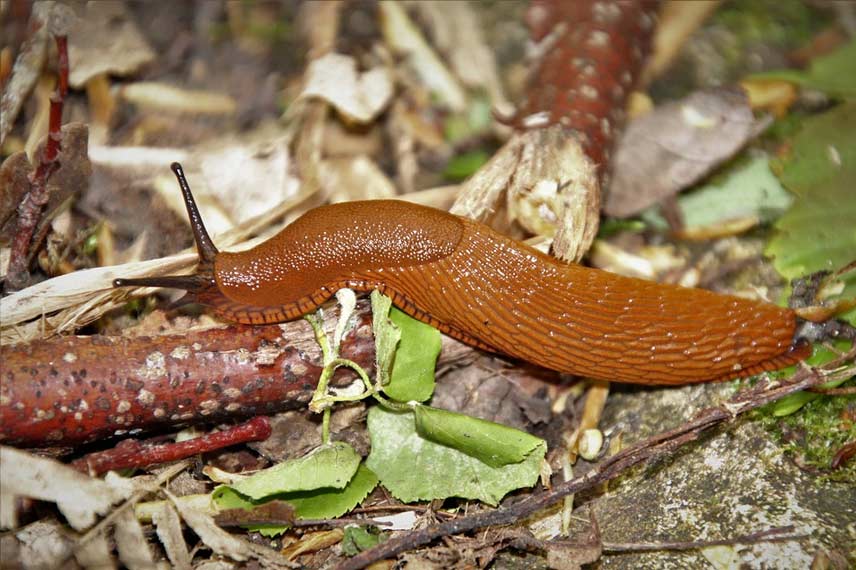
Slug, the main pest of Mertensia maritima
Note that in case of high temperatures, the vegetable oyster can also be invaded by aphids. As a preventive measure, avoid planting it in full south exposure. Similarly, in southern regions, absolutely opt for a semi-shaded location. To preventively combat aphids, sow nasturtiums near your vegetable garden. Indeed, these pests are attracted to nasturtiums to the point of forgetting other plants.
Multiply the vegetable oyster
As we have seen previously, Mertensia maritima propagates by sowing, but it can also be propagated by cuttings.
Propagation by cuttings of oyster plant
You have several options here:
- In spring, between March and April, plant young shoots of oyster plant in pots filled with a substrate made up of half good potting soil and half sand. Keep the substrate moist, but not overly wet.
- In winter, from February onwards, plant outdoors sections of roots from Mertensia maritima, in containers filled with a substrate made of a mix of river sand and good potting soil.
In either case, install the seedlings in their final position once they are well-rooted.
Collecting oyster plant seeds for sowing
- During autumn, collect the fallen seeds of oyster plant daily.
- Then dry them by placing them in a shaded area.
- Once thoroughly dry, place your seeds in an envelope and keep it dry and cool until sowing.
Good to know: Mertensia maritima produces self-seeding. Therefore, it is quite possible to collect the young shoots from its seeds to replant them further away, either directly in the ground or in pots of turf. However, be careful not to break the stems while harvesting.
Associating Mertensia maritima
The oyster plant can be associated with a rockery, but also with all the vegetables from the garden, such as the French Breakfast radish, cutting lettuce, Carentan carrot, or even the Green Provence artichoke.
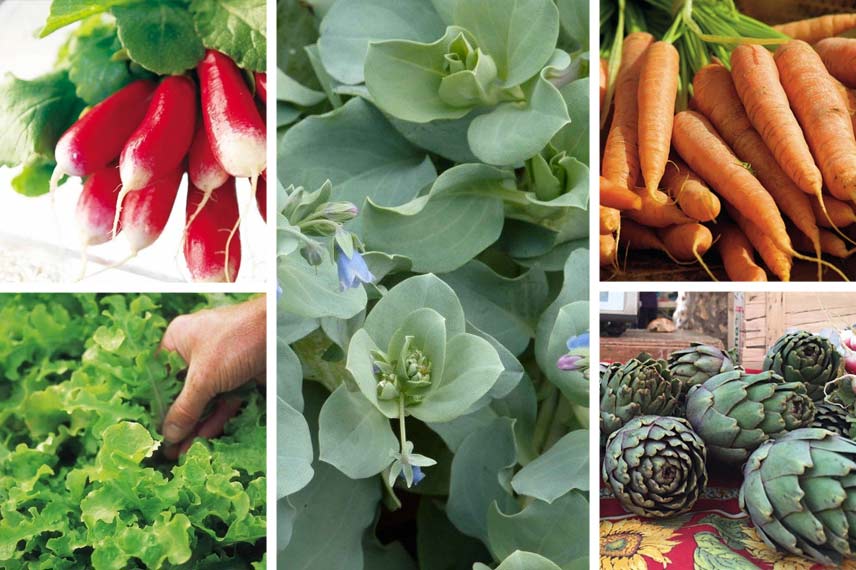
Useful resources
- To effectively protect your young plants of sea bluebell, discover our seven tips to fight slugs effectively and naturally.
- Acquire, with one click, a young plant in a pot of Mertensia maritima from the Promesse de Fleurs online shop.
- Finally, learn how to sow and harvest borage, a plant from the same family as the vegetable oyster.
- Subscribe!
- Contents































Comments